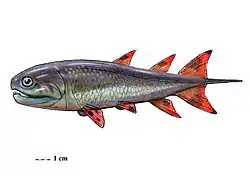Laugia
Laugia is a genus of coelacanth fishes which lived during the Early Triassic epoch in Greenland. It contains one species, Laugia groenlandica, named by Erik Stensiö in 1932.[1] Along with the Early Triassic Belemnocerca and the Late Jurassic Coccoderma, it forms the family Laugiidae. It can be distinguished from other laugiids by its smaller number of tail fin rays: 17–18 in the top lobe and 13–14 in the bottom lobe, compared to 21–22 in the top lobe for the other two genera. Most other coelacanths have symmetrical numbers of tail fin rays.[2]
| Laugia | |
|---|---|
| Laugia slab and counterslab fossils at the Geological Museum in Copenhagen | |
| Scientific classification | |
| Kingdom: | Animalia |
| Phylum: | Chordata |
| Family: | †Laugiidae |
| Genus: | †Laugia Stensiö, 1932 |
| Species: | †L. groenlandica |
| Binomial name | |
| †Laugia groenlandica Stensiö, 1932 | |
References
- Stensiö, E. (1932). "Triassic Fishes from East Greenland collected by the Danish expeditions in 1929-1931". Meddelelser om Grønland. 83 (3): 1–305.
- Wendruff, A.J.; Wilson, M.V. (2013). "New Early Triassic coelacanth in the family Laugiidae (Sarcopterygii: Actinistia) from the Sulphur Mountain Formation near Wapiti Lake, British Columbia, Canada". Canadian Journal of Earth Sciences. 50 (9): 904–910. doi:10.1139/cjes-2013-0010.
This article is issued from Wikipedia. The text is licensed under Creative Commons - Attribution - Sharealike. Additional terms may apply for the media files.

.jpg.webp)


